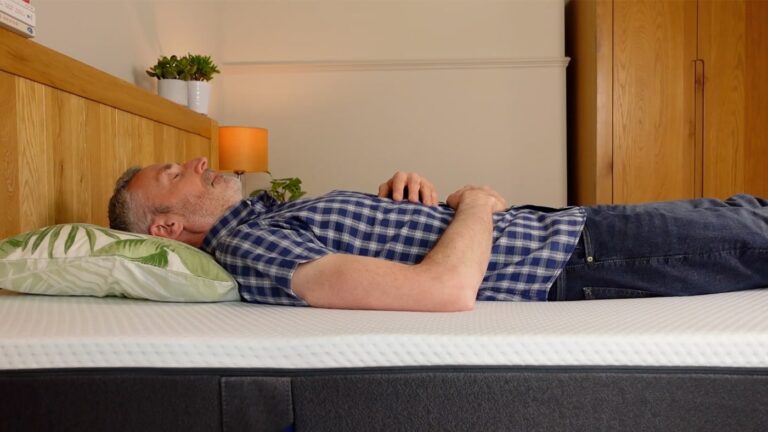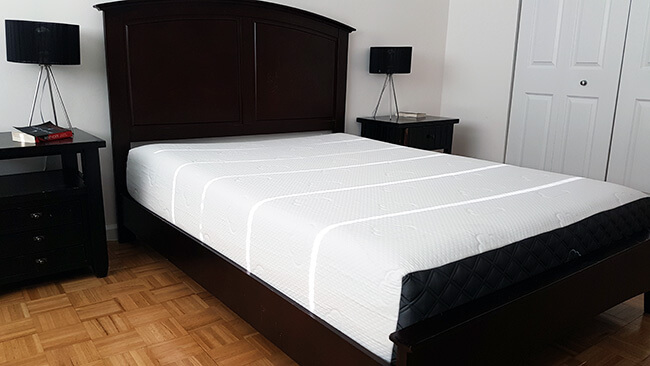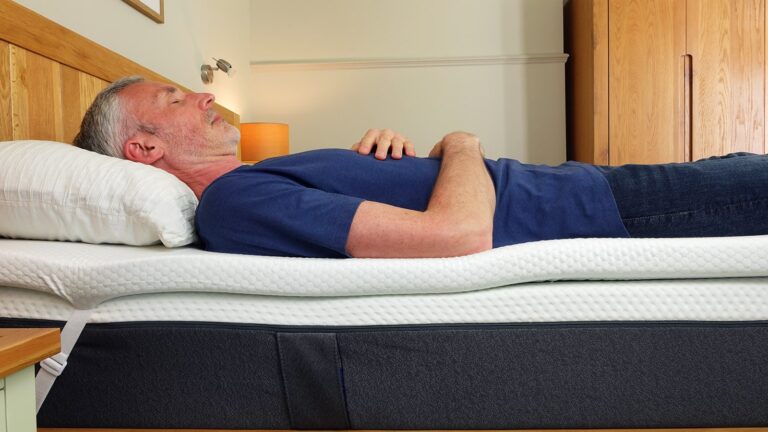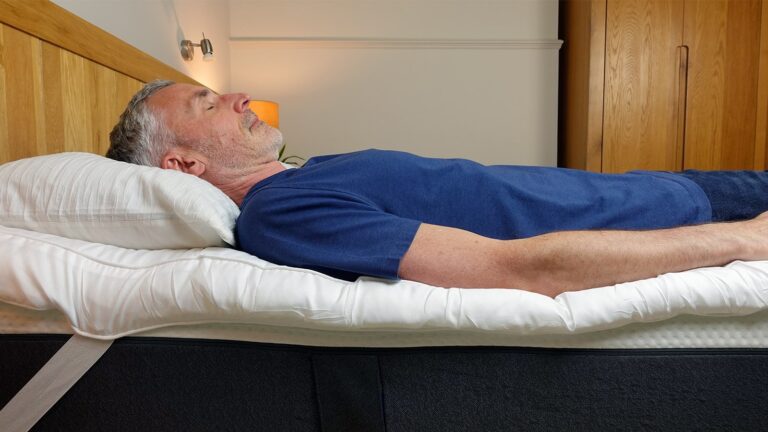Disclosure: My website is reader supported. If you choose to buy a product after clicking a link, I may earn a commission, at no extra cost to you. Learn more.
Overview
I tested six weighted blankets to find out how breathable they are, and also compared the heat buildup with normal bedding.
You can watch the full test in the video above, or read the transcript below.
You can also skip to the results section, which includes the links to visit the company websites if you’d like to find out more or buy any of the blankets.
I first published this video and article in December 2020. In 2025, the winner is still the most breathable weighted blanket I’ve tried and remains my top pick for hot sleepers.
Video transcript
Please note that I made a few edits to the transcript so it’s clearer to read.
Introduction
Hi! I’m Ethan Green from nosleeplesnights.com, and in this video/article I’m going to be focusing on the breathability of weighted blankets.
I’ve covered weighted blankets previously, so if you’re looking for more of a general overview of weighted blankets – how to choose them, do they work – take a look at these articles:
But if you’re someone who’s more interested in how hot weighted blankets feel when you use them, whether there’s really such a thing as a cooling weighted blanket, or how breathable they are – especially comparatively and compared to normal bedding – then hopefully this video will be useful for you.
What I’m going to do is a little experiment. I call it a little experiment because it’s not exactly scientific, but I’m going to do my best. I’m going to use this little thermometer here, and I’m going to put it into the air gap between my body and the weighted blankets.
I’m then going to use each of the weighted blankets for 30 minutes at a time, have a cooling-off period between them, and see what the temperature builds up to within 30 minutes.
I’m also going to talk about how I feel because I’m kind of predicting that the thermometer is going to be largely influenced by the heat emitted by my body. And 30 minutes isn’t exactly the same as using it all night.
However, I feel that talking about them and how I feel in different parts of my body using them for that period of time will probably be a more useful overview of what they’re like. So without further ado, I’m going to get changed into my pyjamas, aka shorts and t-shirt, and I’m going to test the normal bedding first and then the weighted blankets.
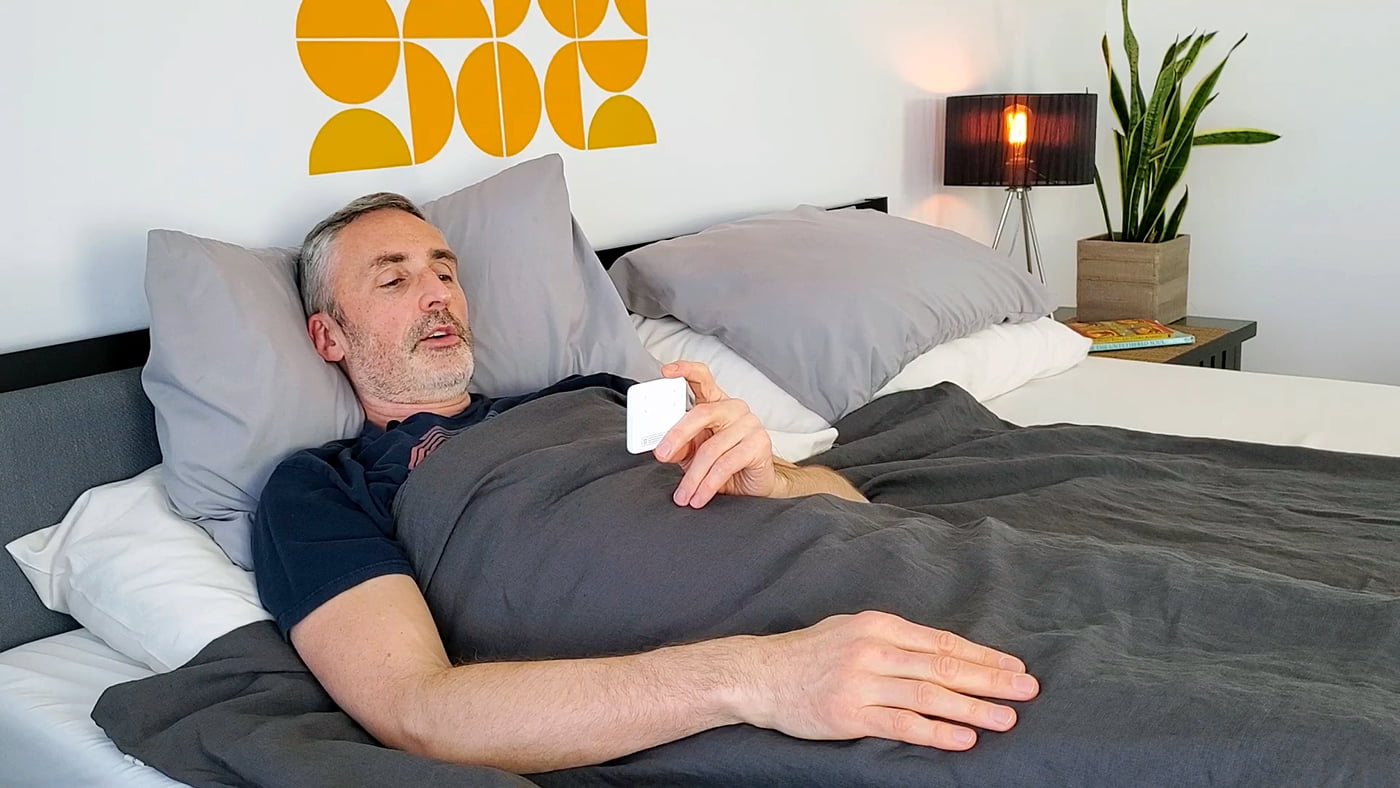
Baseline one: warm 10.5 tog duvet
Before I do the weighted blankets, I’m going to start with a couple of baselines. First with my duvet and then just a sheet. So this is the winter duvet that I use in cold weather. It’s a pretty standard duvet – nothing too special. Normal polyester fiberfill and a cotton cover, but it’s pretty thick so it’s a good one to use when it’s cold outside.
I’ve got my timer – 30 minutes I’m going to do. It’s also my entertainment system while I’m lying here for 30 minutes doing nothing! And my thermometer, which is currently showing 70.2°F which is pretty much what I’ve got the room temperature thermostat set to.
When I stop talking, otherwise it’s going to rustle my microphone, I’m going to put it under the duvet in this little pocket of air there and seal it with my arm to make sure that there’s nowhere for the air to escape. And that way, hopefully, we’ll be able to see what the temperature is like. So, 30 minutes and I’ll be back to tell you about it.
30 minutes later…
Okay, 30 minutes later and the thermometer is showing 78.7°F. So that little air pocket next to my body is considerably warmer than the room air temperature, which is what I expected really from wearing a winter duvet over the top of me in the daytime with the heating on. So now let’s do another baseline, which is going to be just a cotton sheet.
Baseline two: 300 thread count cotton bedsheet
My next baseline is this plain cotton sheet. It’s a 300 thread count cotton sheet, nice and lightweight, the kind of sheet that I’d use in very hot weather. So 30 minutes and let’s find out how this feels.
30 minutes later…
After 30 minutes, I have some bad news. The thermometer is showing 77.5°F, which isn’t as cool as I was expecting. And it’s only a little bit less than the duvet. So either my experiment is completely flawed and just having the thermometer right next to my body is going to be problematic, my duvet is not as warm as I thought it was, or the sheet is much warmer than I thought it was.
Either way, it’s not looking good for the rest of the experiment! But at least it’s less than the duvet. If it had been more, I’d have been even more worried. However, the most important thing is how I feel, as I said earlier. And I do feel much cooler under this sheet than I did with the duvet, which I think would be obvious to guess.
All the way from my toes up to my chest – it just feels much cooler and much lighter. So there you go, let’s move on with the weighted blankets and see what kind of temperatures they yield.
Gravity blanket with microfleece duvet cover
So, the first of the weighted blankets. I’m going to start off with the Gravity blanket. I don’t actually expect this one to be the coolest – I’m not doing these in order of the ones I think are definitely going to be the coolest.
I’m doing this one because I actually own two different Gravity blankets: the standard microfleece one, which I’ve got here, and the one that they say is the cooling duvet cover. So I thought it would be really interesting to do a like for like comparison. If one brand can create two different duvet covers and two different weighted blankets that have different temperature properties, then that gives me some hope that other companies will be able to as well.
So it’s going to be the first interesting experiment to do within the experiment. So here we go, 30 minutes, let’s find out what the temperature is like.
30 minutes later…
30 minutes later with the microfleece Gravity blanket version and we’ve hit 81.6°F, which is obviously warmer than both the sheet and the duvet, which is what I was expecting.
Whether that’s an enormous amount warmer or not, I guess is going to be an individual opinion. What I can say is that I definitely feel warmer, especially in my lower limbs. My feet and my legs feel pretty cozy underneath this compared to the duvet and the sheet, especially compared to the sheet.
But I still feel comfortable – I could lie like this for considerably longer. This temperature isn’t a problem at the moment. So now I’m going to try the cooling duvet cover version of the Gravity blanket and see whether there’s a difference.
Gravity blanket with the cooling duvet cover
This is Gravity’s cooling weighted blanket then. It’s going to be very interesting to see whether just changing the duvet cover, the material of the duvet cover, can make a big impact on the heat buildup or not. The microfleece one before, which is a material that’s commonly used by weighted blanket companies, does have that warm feel.
And this one is polyester – a specific polyester they say has been designed to be like sportswear that wicks away your body heat. So it’s going to be very interesting to see whether it makes that much of a difference to the heat buildup or not considering the inner section is the same. 30 minutes – let’s find out.
30 minutes later…
30 minutes with the cooling Gravity blanket and we’ve hit 78.2°F, which is actually impressively lower than I expected it to be. It’s considerably cooler than the standard microfleece duvet cover. It’s cooler than the duvet and just a little bit more than the basic sheet.
So I’m actually really impressed by this. I expected it to be warmer, even though they call it the cooling weighted blanket. Perhaps I’ve been a little bit more skeptical of it than I should have been. And actually, it feels very comfortable.
My lower body particularly feels still quite cool against the skin when I move my legs underneath the blanket – the underside of the blanket. And my upper body feels very comfortable. I feel like I could lie like this, if it stayed this temperature, for quite some time. So the cooling Gravity blanket – I’m actually quite impressed. So let’s try out the next one.
Bearaby Cotton Napper
I’ve been doing some thinking and decided that the introductions to each blanket or cover are going to be boring and repetitive! So I’m going to dispense with those and just talk about the results.
So this is the Bearaby Napper. I’ve been lying under it for 30 minutes and the temperature is showing as 74.2°F, which is a really good result for this one. It’s cooler than even the bed sheet, which I wasn’t expecting at all.
The reason I’m thinking it’s so effective is because this is a very unique weighted blanket. They don’t have pockets filled with microbeads, polyester, or cotton filler, and then the duvet over the top. It’s just this giant cotton weave. And that weave means that there are air holes all the way through, which I’m guessing is what’s allowed the temperature to remain relatively low.
For me, this actually feels cool as well from head to toe. It’s a breathable and cool feeling weighted blanket comparatively. So it’s a really good result for the Bearaby Napper.
Luxome
This is the Luxome weighted blanket. Luxome produces a lot of different duvet covers for their weighted blankets, and this one I’m using is sold specifically under the category of cooling weighted blankets. And that’s because it has Minky on the top side and the underneath is bamboo, which does feel cooler to touch.
The thing is, it’s got all the rest of the material. And I’ve long wondered whether you can really call something cooling just because it has one thin layer of cooler material, when you’ve got loads of other warmer materials on top.
And that’s what my thermometer is showing. It’s come out at 80°F, which is comparatively warm. And it feels warm as well, importantly. From my toes to my chest, I can feel the heat building. So I’m going to have to dispute the use of the word cooling in this case.
But overall, I do really like the Luxome weighted blankets, and I think it would be ironically a good one for colder weather. So that’s the Luxome. Let’s move on to the next one.
Slumber Cloud
Next up, we have the Slumber Cloud weighted blanket. Slumber Cloud is technically a cooling bedding company. They specialize in cooling materials, using what they call the Outlast technology. And so far it’s pretty good – 76.2°F. So that’s a relatively low temperature that’s built up in there.
It actually feels quite cool across the body as well. It has a nice cool touch, even on the outside. And on the inside, even after 30 minutes, it feels pretty cool against my skin too, so I’m quite impressed with this one.
One thing I will say is that they don’t really have many options – just a 20 pound weight. There are no cover options – it’s just this one piece. And it’s not exactly the softest either. So if you’re looking for a soft and cozy weighted blanket, this wouldn’t be it. But it’s definitely one to consider so far where cooling is concerned.
Baloo with French linen cover
So here we have the Baloo, which is a weighted blanket that I personally really like. It actually came out top in my previous review of weighted blankets when I compared seven different ones. And the fact that it was more breathable than most was one of the things that I really highlighted about it.
However, in this particular test it’s not really the most breathable – it’s come out at 78.9°F. I do wonder whether that’s in part because they’ve changed the materials. I know the previous Baloo that I used for that review had polyester filler, and this one’s got cotton. I wouldn’t expect cotton changed from polyester to make much of a difference to the breathability. Perhaps they’ve just used more or less padding than before.
I don’t know, so I’m kind of curious to understand what’s happening there because I’ve always rated this one for being breathable. It actually feels quite warm as well, so it’s not just the temperature. I can feel that it’s warmer than I was perhaps expecting from it.
Another thing to note about this one is that it has the cover here, the French linen, which I wouldn’t normally use myself because I really like the look of the internal blanket. I think it’s one that you can use without a cover. So I’m going to take off the cover and do one more test, try it for another 30 minutes, and see whether I’m right about that or whether it doesn’t make much difference.
Baloo without a cover
After 30 minutes, the Baloo without the cover is showing as 78.4°F. And that’s not much of a drop really – I was expecting it to be a little bit more than that. It might just be that in this case the French linen cover that they use is so thin that it doesn’t have much of an impact.
Or it could be, as I’ve suspected for a while, that when it comes to weighted blankets the main section that controls the breathability or the heat buildup is the internal weighted blanket, with all the pockets and the beads and the filler. Not so much the cover.
Perhaps if the cover is a really thick Minky on both sides, it might have more of an impact. But if it’s just thin cotton, or French flax linen in this case, then maybe it doesn’t really have that much influence on the overall breathability.
I would say that I do feel that it’s slightly more breathable, a little bit cooler, without the cover. At the same time, I’ve got to be careful how much I want it to feel cooler or more breathable because the Baloo has been a weighted blanket that I’ve really liked for a long time.
But overall, I don’t think it makes that much difference whether you use the cover or not if you’re trying to control the breathability in this case.
Results
That concludes my test of the weighted blankets, the bed sheet, and the duvet. So let’s put them in order of the temperatures first to see whether that shows any big differences that are interesting or of note.
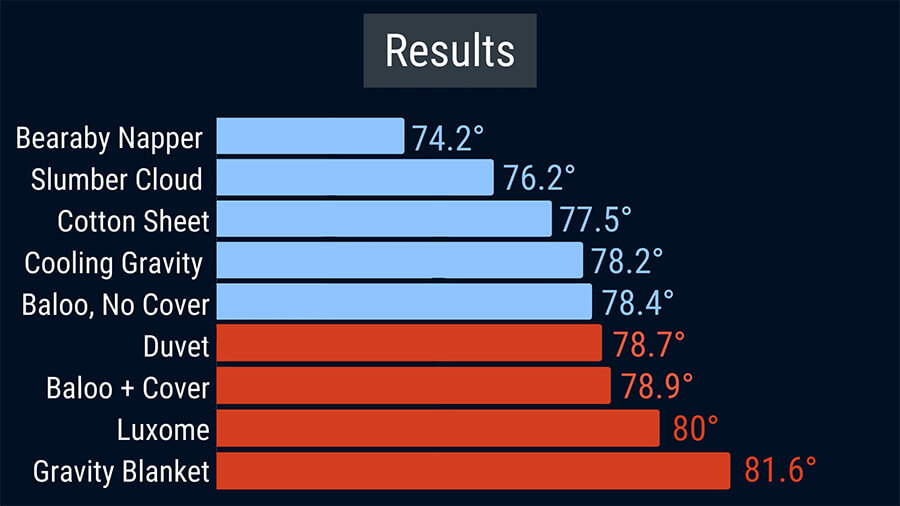
First, we’ve got the Bearaby at 74.2°F. Then the Slumber Cloud at 76.2°F. The bedsheet at 77.5°F – I’m kind of surprised it wasn’t the coolest. The Gravity cooling duvet cover 78.2°F. Then the Baloo without a cover 78.4°F. The duvet 78.7°F. The Baloo with the cover 78.9°F. The Luxome 80°F. And the Gravity blanket with the microfleece duvet cover 81.6°F.
Links to buy the weighted blankets
If you’d like to find out more about any of the weighted blankets in my test, or buy one, you can find them through these links:
- Bearaby Napper (coolest) – Bearaby.com
- Slumber Cloud – Slumbercloud.com
- Gravity cooling blanket – Amazon
- Baloo – Balooliving.com
- Luxome – Luxome.com
- Original Gravity (warmest) – Amazon
My thoughts on the results
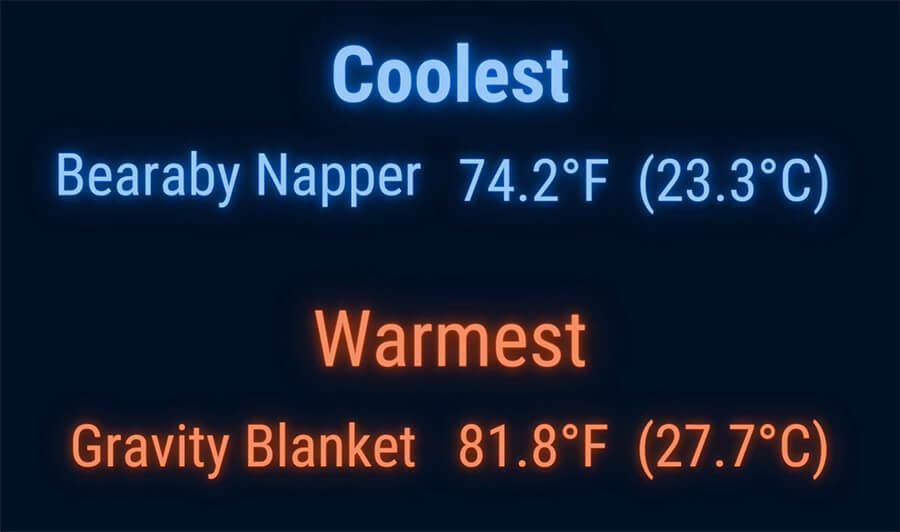
First of all, it’s really clear that there’s a big difference between the coolest one and the warmest one. That’s what the temperature shows, and it’s also what I felt when I was testing them. So it’s good to see that my experiment at least spotted the big difference between the winner and the loser, shall we say.
Another thing I think is interesting to see is that there’s a big difference between the Gravity cooling blanket and the standard Gravity blanket. It’s good to see that there’s a difference between the duvet covers that a company offers.
It perhaps gives optimism that if a company says one is warmer, more breathable, or cooler than another, even though it might not exactly be cooling, it’s perhaps going to feel cooler and more breathable than some of their other options.
Another point that I think is really obvious here is that the two warmest ones – the Luxome and the standard Gravity blanket – both use either a microfleece or a Minky polyester exterior in the duvet cover.
I think that’s a really interesting point to bear in mind. If you’re looking for a warm one, then look for that Minky or microfleece duvet cover – but not if you’re a hot sleeper.
What I think the experiment has shown is that even if you’re a hot sleeper, there is an option or two out there for you that’s worth considering. And if you’re a cold sleeper, there are definitely options for you.
So there you go, that’s the end of my experiment. I hope that you found it useful and interesting.
Extra thoughts since doing the test
As I said at the start, I tested these weighted blankets a few years ago, but the Bearaby is still the most breathable one I’ve tried in the time since then.
I’ve tried a few different weighted blankets more recently and written articles about a couple that I thought were interesting to discuss (the YNM and CosiHome). Neither of them were as breathable as the Bearaby or SlumberCloud.
Having said that, there are other companies now making weighted blankets with a a similar chunky weave – some with cotton, some with other fabrics.
If there’s one you’ve had your eye on, it might be worth trying if it seems to tick all the other boxes for you. At the end of the day, air holes are air holes, so if it has them it’s likely to feel cooler than one with a solid design.
I’d just keep in mind that Bearaby is known for making high-quality weighted blankets and having a good ethos where sustainability is concerned. So if those are also factors that are important to you, hopefully you’ll be able to find out a bit more about the other companies making blankets with the chunky weave design.

